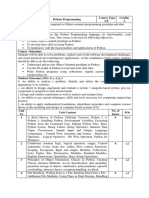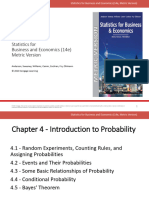Introduction To Python
Uploaded by
The TopTeN CircleIntroduction To Python
Uploaded by
The TopTeN CircleIntroduction to Python / Python for Data Science
CI: Hasan M Sami
Lecturer, DAF
North South University
Course Details: It’s a course designed for students with or without prior programming experience who
would like to learn Python. The course is planned to give them insights regarding Python and its
application in real-world business. Students are introduced to core programming concepts like data
structures, conditionals, loops, variables, and functions. This course includes an overview of the various
tools available for writing and running Python and gets students coding quickly. It also provides hands-on
coding exercises using commonly used data structures, writing custom functions, and reading and writing
to files. This course may be more robust than some other introductory Python courses, as it delves deeper
into certain essential programming topics. At the end of this course, students will have 5 different easily
interpretable exercises which can be showcased in their GitHub or Google Colab profile. This course
mainly attempts to remove the fear of business or humanities students to apply programming concepts
to real-life problems. Mostly in the current world derived by technology, this course will be a direction of
their application career.
Course Objectives: This course is designed as a hands-on practice-based experience class where basic
concepts like writing codes and applications will start with functions and conditional arguments. After
that, we will proceed to solve the practice problem for each learned material. The course will also have
an online repository where additional practice questions discussed in the class are provided with
solutions. Finally using them will magnify our skills.
Real life Applications: Observing the current world trend it seen that in the last 10 years, only nearly 550
universities alone in the USA have opened a program or specialization or certification course for either
Data science or business Intelligence or Business Analytics. All the BIG 4 have found the highest surge of
job requirements also in the business analytics sector. Hence the knowledge of programming is a must
under the current trend. This course is the beginning of the journey toward achieving the dream of major
placement of university students in the international job market.
Module 1: Introduction -- Relationship between computers and programs -- Basic principles of computers
-- File systems -- Using the Python interpreter -- Introduction to binary computation -- Input / Output
a) Simple Python Calculator
b) Python Program to check Prime numbers in an interval
c) Python Program to produce a Fibonacci series
Module 2: Data types and control structures -- Operators (unary, arithmetic, etc.) -- Data types, variables,
expressions, and statements -- Assignment statements -- Strings and string operations -- Control
Structures: loops and decision
a) Python program to access dictionary values using keys
b) Python program using Loops to create Pyramid pattern
c) Python program to merge dictionaries and Slice lists
Module 3: Modularization and Classes -- Standard modules -- Packages -- Defining Classes -- Defining
functions -- Functions and arguments (signature).
a) Building an Interactive Quiz
b) Making a temperature converter from web input
c) Build an alarm clock for effective routine
Module 4: Exceptions and data structures -- Data Structures (array, List, Dictionary) -- Error processing --
Exception Raising and Handling
a) A counter App when users are added
b) A Number guessing Game
c) Sorting algorithm
Module 5: Object oriented design -- Programming types -- Object Oriented Programming -- Object
Oriented Design -- Inheritance and Polymorphism
a) Determining different customer classes using Python libraries like (Pandas, NumPy, etc.)
b) IRR generator from multiple investments
c) Build a chatbot
Numerous other examples will also be provided through the course web page/link. There will be an open
discussion forum for this course where everyone can discuss and share their problems.
You might also like
- Course Code CSE3011 Python Programming Course Type LP Credits 3No ratings yetCourse Code CSE3011 Python Programming Course Type LP Credits 33 pages
- Project File College Management System1No ratings yetProject File College Management System114 pages
- FAQ - PCAP Programming Essentials in Python (December 19, 2017)No ratings yetFAQ - PCAP Programming Essentials in Python (December 19, 2017)9 pages
- Python Programming and Data Exploration in Python (PPDEP)No ratings yetPython Programming and Data Exploration in Python (PPDEP)2 pages
- FUNDAMENTALS OF COMPUTER PROGRAMMING-SyllabusNo ratings yetFUNDAMENTALS OF COMPUTER PROGRAMMING-Syllabus10 pages
- Bey Z., Whittaker S. B. - A Masters Course in Python With Certification - 2023No ratings yetBey Z., Whittaker S. B. - A Masters Course in Python With Certification - 2023187 pages
- Brochure PythonForManagers 07-07-2022 V57No ratings yetBrochure PythonForManagers 07-07-2022 V5717 pages
- C and Python Applications: Embedding Python Code in C Programs, SQL Methods, and Python Sockets Philip Joyce 2024 scribd download100% (2)C and Python Applications: Embedding Python Code in C Programs, SQL Methods, and Python Sockets Philip Joyce 2024 scribd download50 pages
- Industrial Internship: WEEK 7 (FROM JUN 7, 2021 TO JUN 11, 2021)No ratings yetIndustrial Internship: WEEK 7 (FROM JUN 7, 2021 TO JUN 11, 2021)5 pages
- Ise 589 004 Python Programming For Industrial EngineersNo ratings yetIse 589 004 Python Programming For Industrial Engineers2 pages
- Why Students Should Get Python Programming Classes OnlineNo ratings yetWhy Students Should Get Python Programming Classes Online4 pages
- C and Python Applications: Embedding Python Code in C Programs, SQL Methods, and Python Sockets Philip Joyce - Get instant access to the full ebook with detailed content100% (1)C and Python Applications: Embedding Python Code in C Programs, SQL Methods, and Python Sockets Philip Joyce - Get instant access to the full ebook with detailed content60 pages
- Python Data Handling - A Deeper Dive - Live TrainingNo ratings yetPython Data Handling - A Deeper Dive - Live Training4 pages
- Hamoye Data Science Internships Handbook Spring 2024No ratings yetHamoye Data Science Internships Handbook Spring 202429 pages
- Python and Competitive Programming Mastering Coding Challenges in NagpurNo ratings yetPython and Competitive Programming Mastering Coding Challenges in Nagpur4 pages
- Deep Learning Prerequisites: Logistic Regression in PythonNo ratings yetDeep Learning Prerequisites: Logistic Regression in Python8 pages
- The Python Bible For Beginners 1724508132No ratings yetThe Python Bible For Beginners 1724508132186 pages
- What Are The Reasons Behind Increasing Demand For PythonNo ratings yetWhat Are The Reasons Behind Increasing Demand For Python6 pages
- Uruguay Program-Overview-2021 All-1 CompressedNo ratings yetUruguay Program-Overview-2021 All-1 Compressed28 pages
- DBA4714-Deep-Learning-Generative-AI-in-Business_R1No ratings yetDBA4714-Deep-Learning-Generative-AI-in-Business_R13 pages
- Hyderabad Institute of Technology and Management Faculty PresentationNo ratings yetHyderabad Institute of Technology and Management Faculty Presentation19 pages
- Learn Python Programming for Beginners: The Best Step-by-Step Guide for Coding with Python, Great for Kids and Adults. Includes Practical Exercises on Data Analysis, Machine Learning and More.From EverandLearn Python Programming for Beginners: The Best Step-by-Step Guide for Coding with Python, Great for Kids and Adults. Includes Practical Exercises on Data Analysis, Machine Learning and More.4/5 (2)
- Local Case: MGT - 489 Sec: 07 Submitted To S.S.M Sadrul Huda (SSH2) Associate Professor Dept. of ManagementNo ratings yetLocal Case: MGT - 489 Sec: 07 Submitted To S.S.M Sadrul Huda (SSH2) Associate Professor Dept. of Management7 pages
- Summer 2021 - Lecture 2 - Linear ODEs of First Order and ModellingNo ratings yetSummer 2021 - Lecture 2 - Linear ODEs of First Order and Modelling25 pages
- Does Emotional Words Take Longer To RespNo ratings yetDoes Emotional Words Take Longer To Resp10 pages
- EMC Testing of Large Inductrial Sytems TCFNo ratings yetEMC Testing of Large Inductrial Sytems TCF6 pages
- SCHNEIDER - Datasheet - Rilux T5 - OVA37027No ratings yetSCHNEIDER - Datasheet - Rilux T5 - OVA370272 pages
- Proportional Directional Valves DHZO-A and DKZOR-ANo ratings yetProportional Directional Valves DHZO-A and DKZOR-A6 pages
- Steel Fiber Reinforced Concrete: Submiited ToNo ratings yetSteel Fiber Reinforced Concrete: Submiited To17 pages
- (Ebook) The Lean Expert: Educating and Elevating Lean Practitioners Throughout Your Organization by Joseph Niederstadt (Author) ISBN 9780429256806, 9781138438156, 9781482253658, 9781482253665, 0429256809, 1138438154, 1482253658, 1482253666 - The ebook in PDF/DOCX format is available for instant download100% (1)(Ebook) The Lean Expert: Educating and Elevating Lean Practitioners Throughout Your Organization by Joseph Niederstadt (Author) ISBN 9780429256806, 9781138438156, 9781482253658, 9781482253665, 0429256809, 1138438154, 1482253658, 1482253666 - The ebook in PDF/DOCX format is available for instant download47 pages
- Steel Reinforcement For Concrete - BS 8666:2005No ratings yetSteel Reinforcement For Concrete - BS 8666:20053 pages



































































































